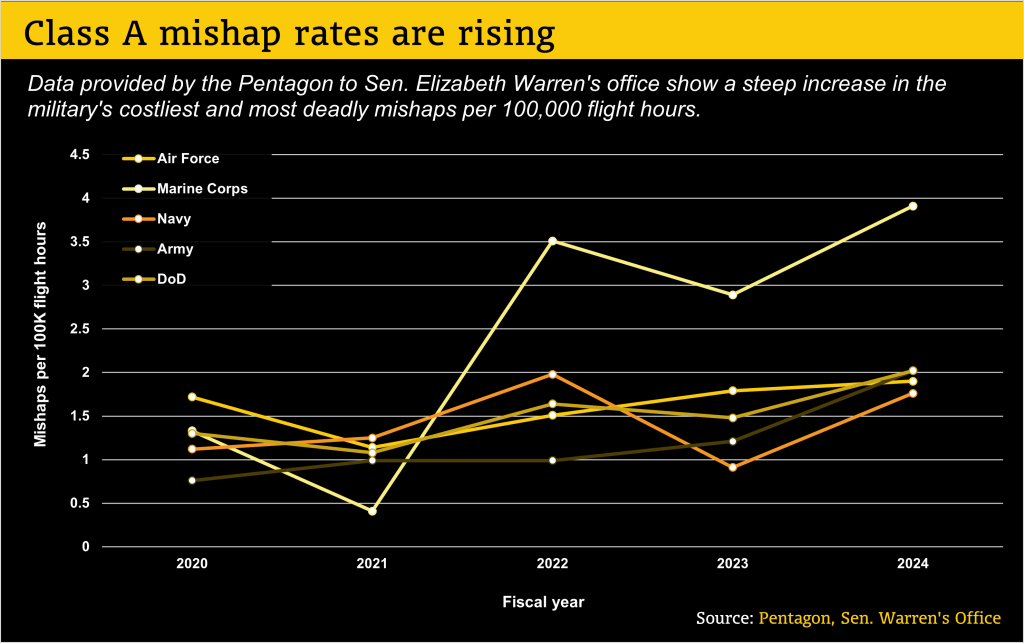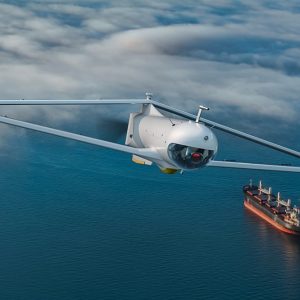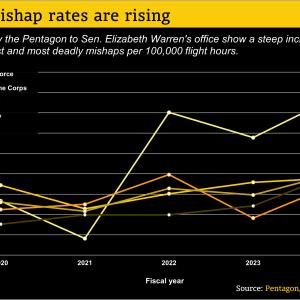Pentagon data shows that U.S. military aviation mishaps have risen sharply over the last four years. The rate of Class A accidents, the most deadly and costly category, has increased by 55 percent since fiscal 2020. Lawmakers, defense analysts, and aviation safety experts now view U.S. military aviation mishaps as a strategic risk to both lives and readiness.

Pentagon data reveals a 55 percent surge
According to figures provided to Senator Elizabeth Warren, the Class A mishap rate grew from 1.3 to 2.02 incidents per 100,000 flight hours between fiscal 2020 and fiscal 2024. Over that period, the services recorded 4,280 total mishaps, 90 deaths, nearly 90 destroyed aircraft, and an estimated $9 billion in damage. These numbers confirm that U.S. military aviation mishaps are rising faster than many leaders had expected.
Each service, except the Navy, reached a four-year high in Class A mishap rates during 2024. The Marine Corps rate nearly tripled, jumping from 1.33 to 3.91 mishaps per 100,000 flight hours. The Army’s rate climbed from 0.76 to 2.02, while the Air Force rose from 1.72 to 1.9 in the same window.
The Navy is a partial outlier. Its Class A rate peaked at 1.98 in 2022, then declined slightly to a range between 1.12 and 1.76. Even so, the overall picture for U.S. military aviation mishaps points to a dangerous upward trend that cuts across the joint force.
Congress pushes for transparency and accountability
Senator Warren argues that the increase in deadly mishaps represents an “unacceptable risk” to service members, their families, and U.S. military readiness. In response, she is using the latest data to push for new provisions in this year’s defense policy bill. These measures would require the Pentagon to share summaries of internal aviation safety reports from the last three years with Congress.
In a new letter to Defense Secretary Pete Hegseth, Warren is now requesting updated Class A mishap data for the rest of 2024 and for 2025. She is also asking for detailed figures on mishaps, fatalities, destroyed aircraft, and estimated costs for each service and major aircraft type over the last five years. She has asked the department to deliver this information by early December to support timely oversight of U.S. military aviation mishaps.
The Pentagon, for its part, stresses that its safety oversight council reviews major incidents on a routine basis. Officials say the department seeks to reduce safety risks, invest in best practices, and build a stronger safety culture across all echelons. However, lawmakers and families argue that current reporting still leaves critical gaps in public transparency.
High-risk platforms come under scrutiny
The Pentagon data also highlights which aircraft families bear the heaviest mishap burden. The H-60 helicopter series recorded 23 mishaps per 100,000 flight hours, the highest rate among the top ten most-used aircraft. It was followed by the F-18 fighter and the C-17 transport aircraft, each with 21 mishaps per 100,000 hours.
The V-22 Osprey stands out in a different way. More than one-fifth of all deaths in the Pentagon report occurred in Osprey variants. Since 2022, four V-22 crashes have killed 20 service members, turning the tiltrotor into a symbol of the wider U.S. military aviation mishaps debate.
Families of Osprey victims say the lack of timely, detailed explanations compounds their grief. Many still await full findings from Naval Air Systems Command and Government Accountability Office investigations into the platform. They argue that comprehensive answers and visible accountability are owed not only to bereaved families, but also to the crews still flying these aircraft.
Root causes: flight hours, maintenance, and money
Insufficient flight time and maintenance capacity
Safety advocates and industry experts point to a familiar set of drivers behind rising U.S. military aviation mishaps. High operational tempo, aging aircraft, maintenance shortfalls, and constrained budgets have combined to erode safety margins across several fleets. In many units, pilots struggle to log enough quality flight hours, especially in demanding mission profiles.
Retired Marine Corps pilot and aviation consultant J.F. Joseph notes that safe operations depend on both aircrew proficiency and robust support on the ground. Aircraft require well-trained maintainers, sufficient manning levels, and a steady flow of spare parts. If squadrons lack technicians or components, sorties are delayed, training is compressed, and hidden risks begin to accumulate.
“The cost of doing aviation safely is expensive,” Joseph warns. “It is far more expensive when you are not.”J.F. Joseph, retired U.S. Marine Corps aviator
Budget pressures and fleet cannibalisation
Analysts also connect U.S. military aviation mishaps to years of budget decisions that lagged behind inflation. During this period, the services maintained a high operational tempo in multiple theaters while absorbing rising sustainment costs. As a result, several fleets now rely on stopgap measures rather than long-term recapitalisation.
Mackenzie Eaglen of the American Enterprise Institute notes that services have resorted to cannibalising aircraft for parts to keep other jets flying. In extreme cases, the Air Force has even returned retired B-1 bombers to limited service to meet mission demands. Such measures keep sortie counts up in the short term, but they also signal underlying stress that can fuel future U.S. military aviation mishaps.
For a deeper look at how readiness and maintenance interact, see our related analysis on Air Force readiness and the maintenance gap, which explores long-term sustainment risk.
Services roll out new safety campaigns
Some services have already launched high-visibility efforts to arrest the trend. Before retiring as Air Force chief of staff, Gen. David Allvin announced a force-wide safety and standards campaign. He reported that preventable mishaps had cost the service 47 airmen and $1.5 billion in weapons in recent years.
His successor, Gen. David Wilsbach, has told both Congress and airmen that fixing aging aircraft and boosting readiness will be his top priorities. He has framed safety, training, and modernization as interconnected challenges rather than separate lines of effort. This approach reflects a growing recognition that U.S. military aviation mishaps often emerge from systemic issues, not isolated errors.
Additional context on global aviation mishap trends can be found in Defense News’ aviation safety reporting, which tracks similar pressures in allied air forces.
What comes next for U.S. aviation safety?
The latest Pentagon data makes one point clear: U.S. military aviation mishaps are not a statistical anomaly. They are a warning signal that touches pilots, maintainers, families, and policymakers alike. Reversing the trend will require more than one-off safety stand-downs or isolated investigations.
Instead, leaders will need to sustain higher and more predictable funding for maintenance, parts, training, and modernization. They must also improve transparency so that Congress, families, and service members can understand why accidents occur and how lessons are applied. If that happens, the rise in U.S. military aviation mishaps could mark a turning point rather than a new normal.
For now, lawmakers like Senator Warren are using oversight tools to keep pressure on the department. The Pentagon’s response, and the concrete changes that follow, will shape the safety record of U.S. military aviation for years to come.












